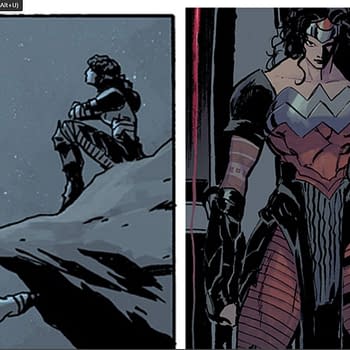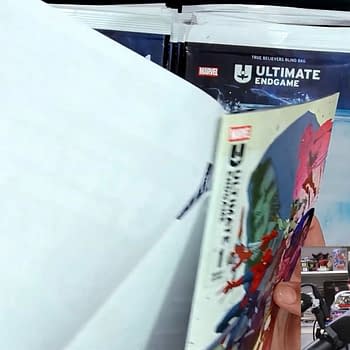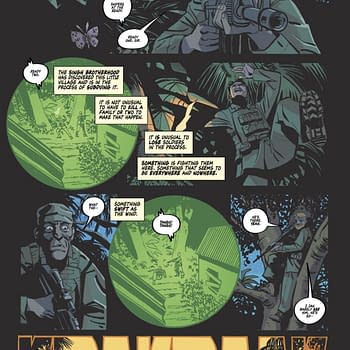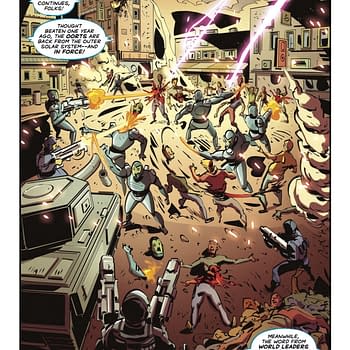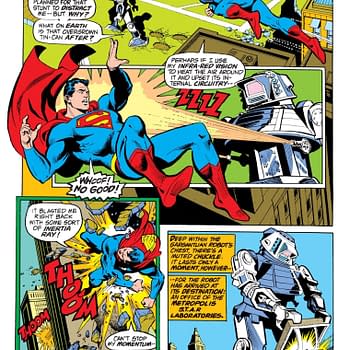Posted in: Comics | Tagged: Comics, jack kirby, roy lichtenstein, sal buscema, sharon moody
Sharon Moody – A Roy Lichtenstein For Our Times
Scott Edelman writes for Bleeding Cool;
I was reading the December 12 issue of the New York Observer when I spotted something that irked me.
What was it in particular that I suddenly felt a need to bring to your attention? Something I saw in a half page ad for the Bernarducci Meisel Gallery. It offered for sale a single painting: "Mjolnir—To Thy Master!"
Take a look for yourself.
The artist's name was … Jack Kirby, right? Wrong. It's the work of an artist named Sharon Moody, and Kirby's name was nowhere to be seen. I investigated a little further, and discovered other similar paintings.
Here's another.
This one's by by Sal Buscema, right? Wrong again. It's also credited to Sharon Moody, and unless you're familiar with comics, you'd have no idea that every line screamed Sal's name. Which is but one of the many reasons these paintings leave me … uncomfortable.
The intended market of buyers for these works of art would probably assume that the comics depicted in them sprang whole from the mind of the artist, and are a commentary on pop culture in general, rather than being line for line reproductions so close to the original comics that the artist might have been better served taking a photograph of the original comic book pages and framing that. Roy Lichtenstein, who I felt was profiteering on the work of great comics artists, at least altered them to suit his own style, as can be seen by this comparison plucked from David Barsalou's site Desconstructing Roy Lichtenstein, which shows a Russ Heath panel side by side with Lichtenstein's recreation.
I never looked at a Lichtenstein without feeling angry on behalf of the unnamed comics artists, because I always felt that a fraud was being perpetrated upon an ignorant audience, one that might assume he was making a commentary on the culture though the tropes of comics in general, as opposed to plundering specific artwork. (I believe any curator of an exhibit of Lichtenstein's work who fails to include reproductions of the original panels falls down on his or her job.) But again, at least he made alterations to the original works, rather than passing along the unfiltered imagery of Joe Kubert, John Romita, and others as his own.
But when it comes to this current crop of paintings, it appears—at least based on the one page I could track down—that not an ink line has been changed. Check out Sharon Moody's painting "The Shadow" side by side with a page from Batman #253 (November 1973) as penciled by Irv Novick and inked by Dick Giordano.
As you can see, they are so identical that the artist might as well have (as I wrote above) photographed the folded issue.
So what does Moody believe she's doing here? According to an Artist's Statement on her site:
Recently I have been making paintings based on games, toys and other forms of entertainment that reflect the universal human desire for amusement, diversion, and stimulation. These seem a proper subject for trompe l'oeil paintings, which by their very nature are intended to divert and entrance us with their illusionism and by the questions they raise—in a playful way—about perception and reality.
Ideas I am exploring include the relatively new (in the entirety of human history) concept of childhood; physical objects used as playthings; the process of play as a way to learn; and the commercial branding of products for sport and play. … Comics are thought of as adolescent fare, and are inexpensively printed for immediate consumption and immediate disposal; Something's Going Down in That Museum Right Now depicts the anticipatory moment of turning the page at the story's denouement.
I could write an entire essay on what's wrong with the penultimate sentence of that quote, as it's been decades since comics could be thought of as a product that's "inexpensively printed for immediate consumption and immediate disposal." But I'm more bothered by the paintings themselves rather than the theory behind them.
You might ask, but what's wrong with this? Aren't these just still-life paintings like any other? Aren't there many trompe l'oeil paintings that can pass for photographs? Why should an artist be allowed to paint a bowl of fruit but not a comic book?
My issue is this—an apple, once you set aside either a Higher Power or human hybridization (depending on your belief system), has no creator, but the pages of art apparently reproduced here line for line do. What's going on here is at the very least a collaboration with Kirby, Buscema, Novick, and others without those artists' permission, and at the very most … well … I'll let others decide whether they want to go there.
And let it be said that I have no problem with sampling, remixing, tributes, homages, allusions, or anything along those lines. I've enjoyed other works that have repurposed existing comics imagery, such as the collages of John Ashbery, which I shared with you here and here, and the photorealistic paintings of Glennray Tutor. And a look at my short stories, which incorporate takes on John Steinbeck, Thornton Wilder, and William Shakespeare, among others, will reflect that I believe in mulching the culture to create new works of art as much as anyone.
As to the copyright and fair use issues which surround the act of perfectly reproducing the words and pictures of another without change, to be honest, that's not what's paramount in my mind. I'll leave that for others to debate. Because mine is not a legal concern, but an artistic one.
See, the thing is—these paintings don't seem to be sampling, remixes, tributes, homages, allusions, or anything as transforming as that. Whatever power they have comes entirely from the unfiltered energy of the great comic book artists—and the writers who worked with them—whose work has been reproduced intact and without acknowledgement. It's one thing to channel them to create something new, to take some of your soul and some of theirs and meld them together into a greater whole. It's something else entirely to offer up the unchanged work of others as your own.











